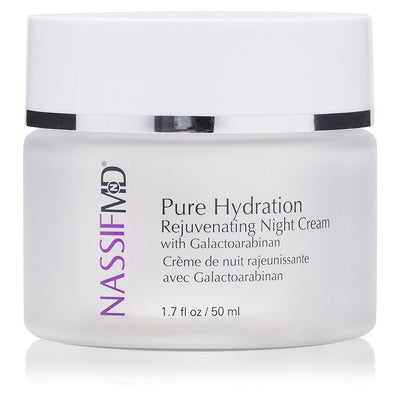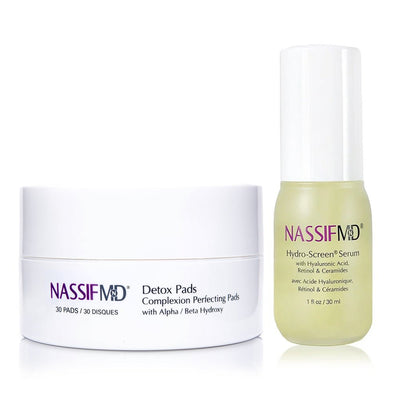Trending Skincare Ingredients Worth the Hype
Your skin is your largest organ; it relies on many nutrients for health and repair. The ingredients you put on your skin matter. With so many skincare ingredient trends out there, how do you know what to spend your money on that will actually work?
The best skincare routine is the one that works for your skin type and issues, using active skincare ingredients backed by research and clinical results. Today’s article will dive into trending skincare ingredients and the tried-and-true essential ingredients you need in your routine.
Keep reading as we cover:
- 5 skincare ingredient trends 2023: niacinamide, tranexamic acid, linoleic acid, mandelic acid, and epidermal growth factor
- 3 essential skincare ingredients: hyaluronic acid, retinol, ceramides
Read carefully for a sneak peek at a new NassifMD® product coming soon!
5 Trending Skincare Ingredients in 2023
Skincare trends come and go, but these active ingredients are likely around to stay. Let’s look at five trending skincare ingredients in 2023 and how you can use them in various skincare routines.
Niacinamide
Niacinamide serum is increasing in popularity in anti-aging skincare.
Form of Vitamin B3
What is niacinamide?
Niacinamide (also called nicotinamide) is a form of vitamin B3 with many skincare benefits when used topically. Vitamin B3 benefits all cells in the body as it’s an antioxidant involved in energy production inside the mitochondria of cells.
Minimizes Fine lines and Wrinkly Skin
Niacinamide benefits wrinkly skin by promoting an increase in protein synthesis, including keratin and ceramides. As a topical skincare ingredient, niacinamide improves skin structure and reduces the appearance of fine lines and wrinkles. Additionally, it improves skin discoloration associated with sun damage.
Promotes a Healthy Lipid Barrier
The best niacinamide serums improve the lipid barrier on the skin’s surface (epithelium). Improved barrier function means less water evaporation and enhanced moisture in the skin. Since dry skin is associated with aging, this function is another way niacinamide improves mature skin and delays skin aging.
Tranexamic Acid
Tranexamic acid is an antifibrinolytic agent used to treat bleeding, but commonly used off-label for skin hyperpigmentation. Doctors prescribe it as an oral medication, but more recently, topical antifibrinolytic agents appear in skincare products.
Improves Skin Discolorations
Melasma and other hyperpigmentation disorders (link to hyperpigmentation article) occur because of aging, sun damage, genetics, and other factors. Many skin-brightening products, such as vitamin C and retinol, work by reducing melanin production. Melanin is the pigmentation molecule in the skin.
Tranexamic acid works by affecting blood vessels in the skin, and works well in combination with other skin-brightening topical ingredients.
Smooths Acne Scars
Acne scars often result in redness and hyperpigmentation of the scar area. Topical tranexamic acid is well-tolerated (and safer than alternatives like hydroquinone). It helps improve skin tone while reducing dark and red areas.
Linoleic Acid
Linoleic acid is an essential omega-6 fatty acid, sometimes called “vitamin F.” Low linoleic acid in the diet contributes to dry skin and inflammation. Dietary sources of linoleic acid include sunflower seeds, walnuts, almonds, and vegetable oils. Many emollient oils used in skincare are good sources of linoleic acid. These include:
- Sunflower oil
- Almond oil
- Argan oil
- Avocado oil
- Shea butter
Slows Signs of Aging Skin
Linoleic acid supports the skin’s structure and integrity, contributing to younger-looking skin. Sunflower oil and other sources of linoleic acid often contain high levels of antioxidants, including vitamin E. Antioxidants protect skin from damage and oxidative stress.
Provides Moisture and Protection
Linoleic acid is a structural component of the skin, part of the lipid barrier that keeps environmental toxins out and holds moisture and nutrients in. Using linoleic acid and oils high in linoleic acid improves skin moisture.
Mandelic Acid
Mandelic acid is an alpha hydroxy acid and natural skin exfoliator. As a skincare ingredient, it’s often derived from almonds and has shown benefits for people with acne-prone skin.
Promotes Collagen Production
Like other alpha hydroxy acids, mandelic acid promotes cellular turnover, which can stimulate collagen production. Collagen provides structure and hydration to the skin.
Strong Exfoliant for Sensitive Skin
Mandelic acid serum and other mandelic acid treatments are strong exfoliators yet may be less irritating than other hydroxy acids. In aging skin, mandelic acid increases sebum production, allowing for exfoliation without increasing dryness.
Coming soon! NassifMD® Even, Correct & Renew
Retexturizing Treatment Pads! Dr. Nassif, a facial plastic surgeon with an intimate understanding of the skin from the inside out, expertly formulated this product with mandelic acid, niacinamide, retinol and HA for those with stubborn skin tone and texture issues. It offers a gentle, effective formula for all skin types, including sensitive and POC skin.
Epidermal Growth Factor
Epidermal growth factor is a peptide therapy for skin rejuvenation in aging skin and wound healing. Epidermal growth factor serums and other products are increasing in popularity.
Stimulates Collagen Production
You may use epidermal growth factor skincare products after laser therapy and other dermatological or cosmetic procedures to improve skin healing. Epidermal growth factor signals cells to increase collagen and elastin production.
Essential Skincare Ingredients
Now that we’ve covered some of the newest skincare ingredient trends, let’s look at some tried-and-true skincare ingredients that have a large body of evidence supporting their use.
Hyaluronic Acid
Hyaluronic acid is a must-have ingredient in your skincare routine, a trend that is definitely around to stay. Hyaluronic acid is a natural molecule with a high safety profile that pulls water into the skin and keeps it there.
Benefits of hyaluronic acid include:
- Improved skin hydration
- Decreased signs of skin aging
- Skin regeneration
- Skin barrier protection
Read more about hyaluronic acid in the article What is Hyaluronic Acid, and Why is it in So Many Skincare Products?
Hydro-Screen Serum
For plump and moisturized skin, NassifMD® Hydro-Screen Serum is an essential daily serum in your skincare routine. This serum hydrates, moisturizes, protects, and restores the delicate skin on your face, neck, and hands. Hyaluronic acid benefits increase when combined with other active ingredients in a synergistic formula. NassifMD® Hydro-Screen Serum also contains ceramides, lipids, retinol, and antioxidants.
Retinol
Retinol is an active form of vitamin A that fights wrinkles and other signs of aging. It’s an antioxidant and promotes cellular renewal and collagen production. It’s even FDA-approved as a topical anti-wrinkle agent. You’ll find retinol in a wide range of skincare products.
Bakuchiol is a natural retinol-like ingredient that may be gentler than retinol for some skin types but just as effective as an anti-aging treatment. It smoothes fine lines and supports and even skin texture and tone.
Detox Facial Pads
Brighten your complexion and promote a younger appearance with NassifMD® Detox Facial Pads that exfoliate, detoxify, and deeply cleanse the skin. Active ingredients include glycolic acid, salicylic acid, lactic acid, bakuchiol, vitamin C, and antioxidants.
Ceramides
Ceramides are another essential skincare ingredient to promote skin health. They are involved in forming the epidermis, the outer layer of the skin, and help provide the vital barrier function that keeps moisture in and protects the skin from the outside world.
Micro-Spa Radiance Resurfacing Peel
The two-step NassifMD® Micro-Spa Radiance Resurfacing Peel combines ceramides with other active ingredients such as vitamin C, peptides, and hydroxy acids to exfoliate and rejuvenate the skin.
With this list of five skincare trends (likely around to stay) plus three skincare essentials, discover what works best for your skin’s unique needs. Often, ingredients work best in synergy, and NassifMD® facial plastic surgeon skincare expertly combines active skincare ingredients to optimize their benefits.
References
- Gehring W. (2004). Nicotinic acid/niacinamide and the skin.Journal of cosmetic dermatology, 3(2), 88–93.
- Lindgren, A. L., Austin, A. H., & Welsh, K. M. (2021). The Use of Tranexamic Acid to Prevent and Treat Post-Inflammatory Hyperpigmentation.Journal of drugs in dermatology : JDD, 20(3), 344–345.
- da Silva Souza, I. D., Lampe, L., & Winn, D. (2021). New topical tranexamic acid derivative for the improvement of hyperpigmentation and inflammation in the sun-damaged skin.Journal of cosmetic dermatology, 20(2), 561–565.
- Poljšak, N., & Kočevar Glavač, N. (2022). Vegetable Butters and Oils as Therapeutically and Cosmetically Active Ingredients for Dermal Use: A Review of Clinical Studies.Frontiers in pharmacology, 13, 868461.
- Wójcik, A., Kubiak, M., & Rotsztejn, H. (2013). Influence of azelaic and mandelic acid peels on sebum secretion in ageing women.Postepy dermatologii i alergologii, 30(3), 140–145.
- Miller-Kobisher, B., Suárez-Vega, D. V., & Velazco de Maldonado, G. J. (2021). Epidermal Growth Factor in Aesthetics and Regenerative Medicine: Systematic Review.Journal of cutaneous and aesthetic surgery, 14(2), 137–146.
- Juncan, A. M., Moisă, D. G., Santini, A., Morgovan, C., Rus, L. L., Vonica-Țincu, A. L., & Loghin, F. (2021). Advantages of Hyaluronic Acid and Its Combination with Other Bioactive Ingredients in Cosmeceuticals.Molecules (Basel, Switzerland), 26(15), 4429.
- Zasada, M., & Budzisz, E. (2019). Retinoids: active molecules influencing skin structure formation in cosmetic and dermatological treatments.Postepy dermatologii i alergologii, 36(4), 392–397.
- Bluemke, A., Ring, A. P., Immeyer, J., Hoff, A., Eisenberg, T., Gerwat, W., Meyer, F., Breitkreutz, S., Klinger, L. M., Brandner, J. M., Sandig, G., Seifert, M., Segger, D., Rippke, F., & Schweiger, D. (2022). Multidirectional activity of bakuchiol against cellular mechanisms of facial ageing - Experimental evidence for a holistic treatment approach.International journal of cosmetic science, 44(3), 377–393. https://doi.org/10.1111/ics.12784
- Kendall, A. C., Kiezel-Tsugunova, M., Brownbridge, L. C., Harwood, J. L., & Nicolaou, A. (2017). Lipid functions in skin: Differential effects of n-3 polyunsaturated fatty acids on cutaneous ceramides, in a human skin organ culture model.Biochimica et biophysica acta. Biomembranes, 1859(9 Pt B), 1679–1689.






















